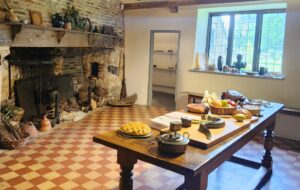*This article may include affiliate links, through which, if a purchase is made, the writer may receive a small commission.
Hexham Abbey, in Northumberland, is not a cathedral, but it has everything you’d love about a cathedral. I love the north of England, and Northumberland has just the kind of wild and woolly, earthy feel that I love about that part of the country. On my last trip to the north, I visited Hexham on my way to Hadrian’s Wall. Hexham is one of the places you can catch or alight a bus to the wall, but it is also a worthwhile destination in itself. Hexham Abbey is a worthwhile destination in itself.
Accommodation and Tours
The Station Inn is where I’ve stayed when in Hexham. It is pub accommodation and although not the closest to the Abbey , it is the closest to the station. It has snug, but comfortable rooms, and good pub meals.
Closer to the Abbey and with excellent reviews is The Coach and Horses
Getting There: Hexham is a major stop on the Newcastle to Carlisle rail line. Book Tickets online through Omio.
Buses, go to nearby Hadrian’s Wall from Hexham. You can also get a guided tour of Vindolanda Roman Fort from Haltwhislte (a few stops on the train from Hexham). You can also join the Gruesome Tour of Hexham!
History
Hexham Abbey is a testament to over 1,300 years of religious and architectural history. Founded in 674 AD by St. Wilfrid, Bishop of York, the Abbey was constructed using stones repurposed from nearby Roman ruins, reflecting a blend of Roman and Anglo-Saxon architectural influences. The original structure included a crypt designed to emulate the catacombs of Rome, which remains one of the oldest parts of the Abbey today. St Cuthbert, of Lindesfarne fame, became the Bishop of Hexham in 684AD. Cuthbert is the patron saint of Northumberland, and they are very proud of him indeed!
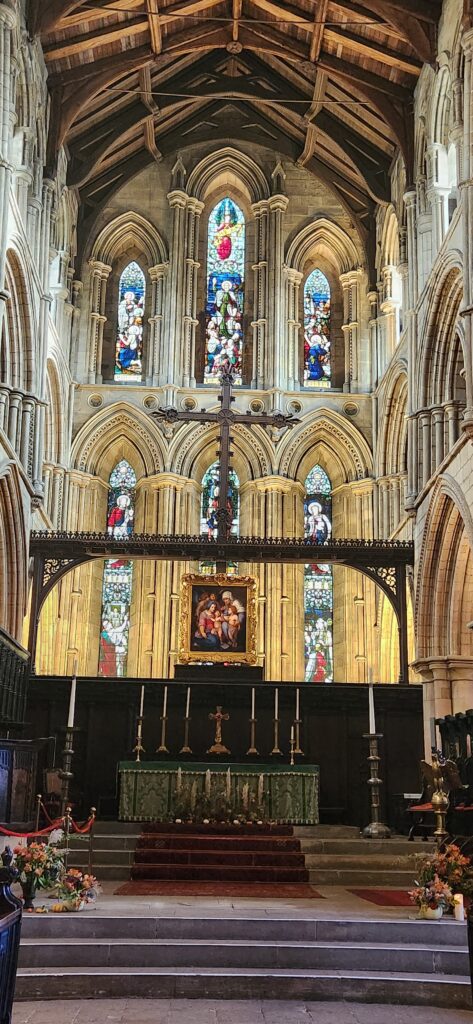
Hexham Abbey has survived a lot. It was attacked in numerous occasions by the Scots, including William Wallace (of ‘Braveheart’ fame), and later by Robert the Bruce. In 875, Viking raids led to significant destruction, and in 1296, Scottish raiders set fire to the Priory, destroying shrines, books, and relics . Despite these challenges, the Abbey has undergone various phases of reconstruction, notably in the 12th century when it was rebuilt in the Early English Gothic style, and in the 19th and early 20th centuries when significant restorations were undertaken.
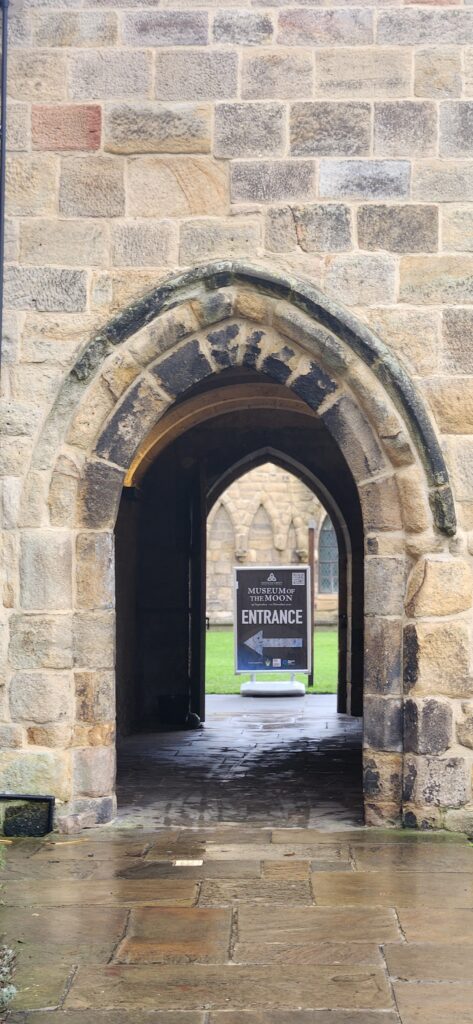
There was also an edict issued by Henry VIII for the Abbey to be dissolved. You’ll find a copy of this edict in the museum attached to the abbey. However it was ransacked in the way other abbeys were, and remained a parish church after that time.
Exhibitions and Activities at Hexham Abbey
Many non-religious events and exhibitions are held here too, including classical music concerts and activities for children. When I was there it was school holidays, and a huge papier mâché moon was hanging from the roof. Unfortunately it completely obscured the organ, so I wasn’t able to take a photo of that. The organ is usually something I photograph when I visit cathedrals and churches!
Opening Times (Including Café):
Monday – Saturday: 10am to 5pm
Sunday : 11am to 5pm
Admission: Adults £3.50 Children £1.00
According to the Website, this admission charge is only for the Crypt, and entry to the abbey is a voluntary donation. However, when I was there, I was charged the admission fee to enter the abbey.
Gift Shop:
Monday – Saturday: 10am to 4pm
Sunday: : 11am to 4pm
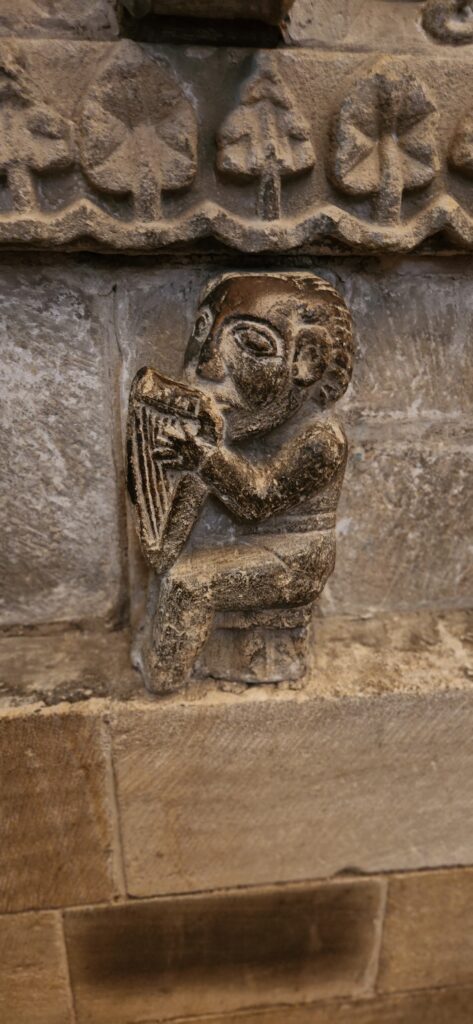
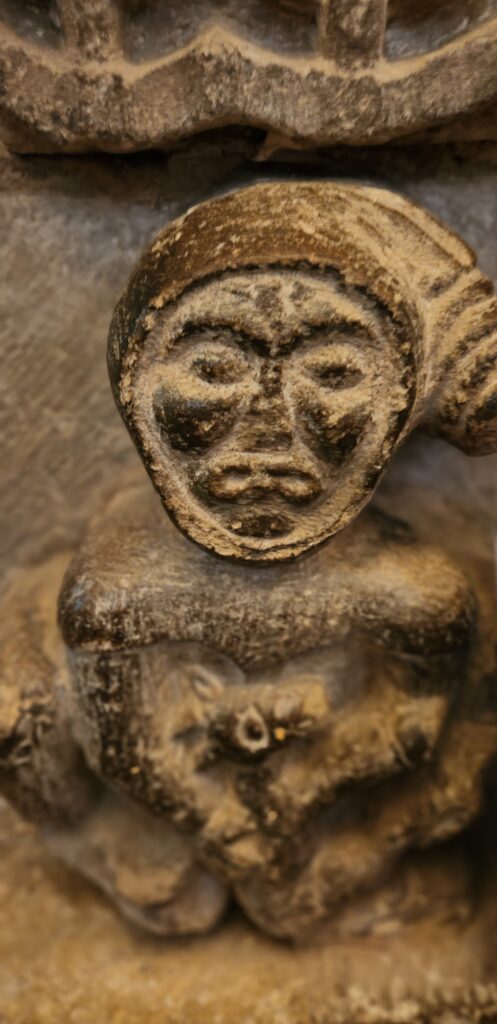

Things to See Inside Hexham Abbey
Visitors to Hexham Abbey can explore a wealth of historical artifacts and architectural features:
- Saxon Crypt: Dating back to the original 7th-century church, this crypt offers a glimpse into early Christian worship practices.
- Frith Stool: An ancient stone seat believed to have been used by bishops, symbolizing sanctuary and ecclesiastical authority.
- Flavinus Tombstone: A 3rd-century Roman tombstone commemorating a standard-bearer, showcasing the site’s deep historical roots.
- Anglo-Saxon Chalice: A rare liturgical vessel from the early medieval period, reflecting the craftsmanship of the time.
- Acca’s Cross: An 8th-century cross associated with Bishop Acca, a successor of St. Wilfrid.
- Dance of Death Panels: Medieval wooden panels depicting the “Danse Macabre,” a reminder of the universality of death.
- Roman and Saxon Stone Carvings: A collection of stones bearing intricate carvings from both Roman and Anglo-Saxon periods.
In addition to these treasures, the Abbey’s museum houses the Hexham Hoard, a collection of 9th-century copper-alloy coins discovered near the Abbey in 1832. They offer insights into the region’s economic history during the Anglo-Saxon era. As mentioned above you’ll also find the edict by Henry VIII to dissolve the abbey.

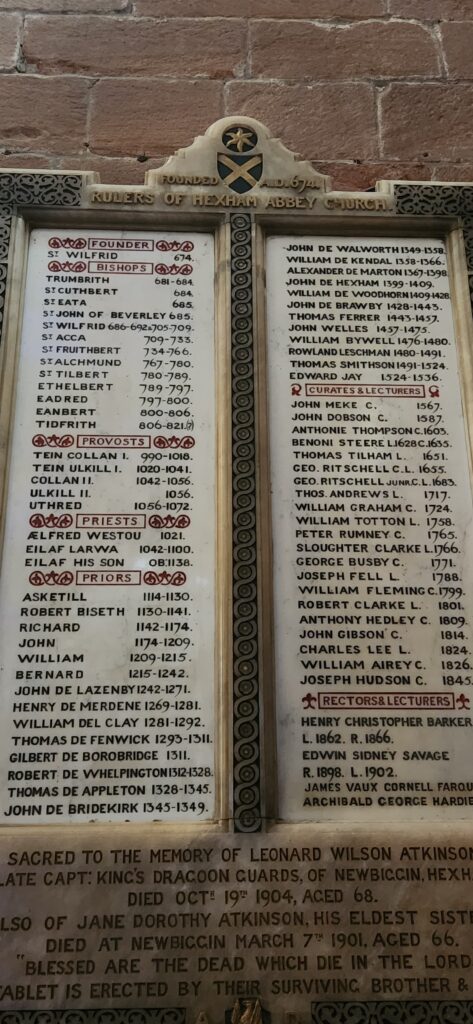


Hexham Abbey continues to serve as a place of worship and community gathering, hosting regular services, concerts, and educational programs. Its rich tapestry of history, art, and architecture makes it a must-visit destination for those interested in England’s ecclesiastical heritage.


